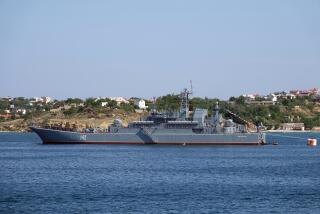Russia to Retire Volatile Torpedo Model Used on Kursk
- Share via
MOSCOW — The Russian navy said Monday that it is scrapping the type of torpedo used on board the doomed nuclear submarine Kursk, which sank in August 2000 after two explosions.
A four-month forensic examination of the submarine exposed shoddy practices in the Russian navy and disproved claims by naval officials that a foreign submarine collided with the Kursk, triggering the tragedy, Russian Prosecutor General Vladimir Ustinov said at a news conference.
The Kursk sank during exercises in the Barents Sea, taking the lives of all 118 crew members. An initial explosion led to a catastrophic blast when other torpedoes detonated, but the submarine’s warheads and reactors were unaffected.
Ustinov said Monday that he was convinced that there was no collision. Five vessels were in the vicinity of the sub, he said, but none was dangerously close.
But the commander of the Russian navy, Adm. Vladimir Kuroyedov, said a separate government commission investigating the disaster is still considering three possible causes: a torpedo explosion, a collision with a foreign submarine and a brush with a World War II mine.
Kuroyedov did acknowledge that the sub’s torpedoes, propelled by volatile hydrogen peroxide, were unreliable. Other countries abandoned them after a 1955 explosion on the British submarine Sidon, he said; the Soviet Union began using them in 1957.
On Monday, Kuroyedov shifted responsibility for the torpedo’s shortcomings to “scientists and designers,” saying the hydrogen peroxide’s “contact with certain metals may cause unpredictable consequences.”
“The torpedoes have already been removed from submarines,” Kuroyedov said grimly. “Now we are considering a replacement.”
Ustinov led the forensic examination of the Kursk, which was raised and towed to port in a delicate operation last fall.
For years, Ustinov said, naval rules were breached aboard the Kursk. A system to send out an emergency beacon was regularly turned off, and the sub’s emergency buoy, designed to mark the craft’s position in case of an accident, was out of order.
Investigators inspected 10 submarine logs, data recorders in the command post and three notes left by crew members trapped in the Kursk, but Ustinov said none explained the cause of the first explosion. He said he hoped that the raising of the bow section, scheduled for this spring, would cast light on the cause of the disaster.
The decision to scrap the torpedo was immediately controversial. Eduard Baltin, a retired Black Sea Fleet commander, said in a phone interview that the move was premature.
“They still don’t know why it exploded, and that is the main thing. Adm. Kuroyedov demonstrates his total incompetence by making such a stupid decision. People die in cars every day, but no one tries to ban cars,” he said.
But retired Rear Adm. Georgy Kostev, former deputy commander of a Northern Fleet nuclear submarine division, said in a phone interview that the decision should have been made years ago.
“These torpedoes have always been a big headache for submariners because they had hydrogen peroxide in their fuel, which is very leaky and can easily cause a fire on board.”
More to Read
Sign up for Essential California
The most important California stories and recommendations in your inbox every morning.
You may occasionally receive promotional content from the Los Angeles Times.













